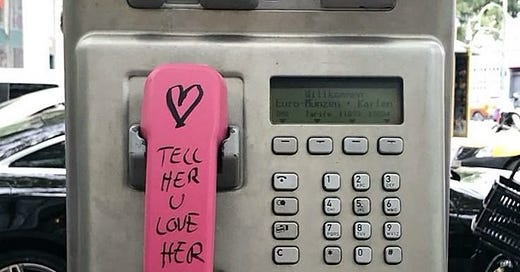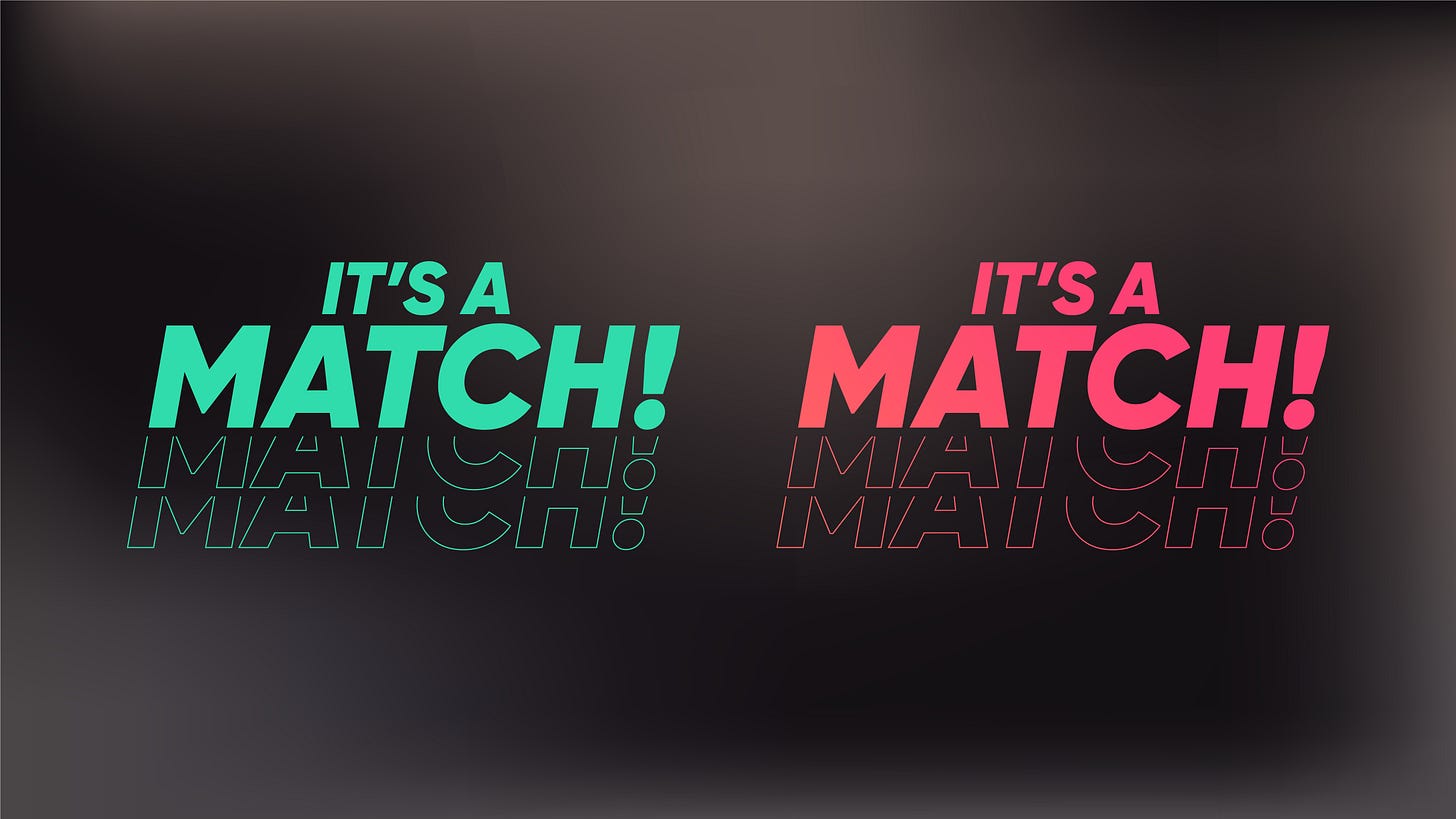In the last few years, a number of online dating applications have announced subscription models for premium users. While some apps charge between $35 and $50 a month, Tinder has explored an option that would cost upwards of $500. Meanwhile, the League, a dating app oriented for exclusivity, costs even more. These astronomical prices beg the question: How much is a dating app worth? And, perhaps more importantly, what are you getting for dropping that kind of money on these apps?
It's also important to point out that—whether a dating app, a streaming service, an online game, and so on—we’re approaching an age where there isn’t just an app for everything, but now there is a subscription for everything (she says in a newsletter that you can subscribe to, hahah.) It’s not enough to have any given app on your phone; now you have to pay for that app. If you don’t, you risk a poorer experience, whether a limit on features, increased advertising, or even (as some consumers believe, including people I’ve interviewed about dating apps!) a worse algorithm.
There was a time when streaming media felt like the future. A way to have unlimited access to unlimited movies, music, TV shows, books, all without having to keep a physical library of these items. Similarly, the cost associated with purchasing physical media was greatly reduced—in many cases, the free version of apps like Spotify made streaming almost too easy. A few ads being the price for unlimited music? How could we ever go back to purchasing physical copies of anything?
Sales of CDs peaked in 2000, with a slight uptick in 2004, before experiencing a steady decrease through 2022. The average cost of a CD in 2004 was anywhere between $14.99 to $18.98; it was big news, in 2004, when Universal Music promised to reduce the price of CDs to just $12.98. At the time, consumers were primed and ready for an alternative: There had to be a better way to access music and access it in a cost-efficient manner. Enter first iTunes and then Spotify, and the groundwork for streaming was laid. Access, not ownership, was on its way to becoming the norm.
This unlimited access has since shaped perceptions not just for consuming entertainment media, but all kinds of media, products, and experiences. The availability of streaming media has fundamentally changed individuals’ expectations of what is possible and when it’s possible. Amazon Prime’s promise of two-day delivery (if not overnight or same day) is a result of the instant availability of entertainment gratification. We expect things to be available and ready for us now.
But this access comes at cost—and a growing cost, that many don’t know how to battle. It’s one thing for one app to offer music at a low price. It’s another for every app to be competing with one another for content. Max has to have content; Paramount+ has to have content; Peacock has to have content; Hulu has to have content; you get the idea. And whether that’s buying existing content or creating new content, advertising is simply not enough to support all of that buying and selling and exchanging, much less that actual hardware needed to support all of that streaming and engaging.
So instead of being in a position where things are better, where media options are unlimited in a way that benefits us, we’re now left navigating multiple apps, unable to find the content we want when we want it.
And maybe that’s why CD sales actually started to rise again in 2022—for the first time in nearly 18 years. Maybe that’s also why sales of vinyl records have continued to increase in the past decade: Vinyl sales have continued to grow into 2025. Suddenly, physical media doesn’t seem like such a bad idea. Maybe we do need to own at least some of our media. Maybe access isn’t enough.
Entertainment media, though, has a history of being available as a physical product, and it’s easy to think about a return to purchasing that physical product. When considering a subscription to an online dating service, this conversation changes. Paying to access a pool of people changes the dating experience that someone is going to have.
Research already shows that online dating can lead to feelings of frustration, particularly when expectations for what the apps and websites can provide aren’t met. People download dating apps or sign up for dating websites for a variety of reasons: Many are seeking serious relationships, whereas others are interested in more casual flings and hookups. Other people download dating apps to make friends, and certainly plenty of people use these technologies for a self-esteem boost. Often, these many uses overlap and intersect; as individuals seek romantic relationships, they also experience self-esteem boosts as their profile gets swiped on and matches come in.
But matches have to come in for these positive outcomes to happen. Instead, there is a growing feeling of disillusionment with online dating: The matches aren’t great, the right people aren’t on the right apps, people aren’t willing to move from dating app to an in-person meeting. The list of issues goes on and on, but they point to a growing trend: Many dating apps are not currently meeting the needs of their consumers.
Add in, now, a subscription component, and the trend is likely to exacerbate. Dating apps are easy to treat as a fun distraction; downloading an app onto your phone doesn’t have to be serious. For many people, Tinder or Bumble or Hinge or Grindr or whatever app they like can feel like just another social media channel to get lost in. Though people are often using the apps for a designated goal (finding love, sex, etc.), the sense of fun that comes with an app can make it feel more carefree. Attaching a price tag, especially a repeating one, changes that initial experience. Now there’s a commitment to the app itself, and that likely means a reevaluation of what one is doing on the app or looking for.
A subscription, at this point, isn’t required for most apps (though some have always had this type of model in order to facilitate exclusivity and/or prestige). However, an increasing number of features are being moved so that they are only accessible at premium tiers—whether that means the option to like more people than on a free version, to see more potential matches, to see existing likes, and more. There is also a sense, as I mentioned, that the algorithm itself is perceived to be worse for those who use the free versions.
When you take a service that has been free or ad-based, especially one that lives on a smartphone, the experience of the person on the other side of the screen is also likely to change. What are the pressures for someone who has been paid for, who was gained via subscription? There is an argument that dating apps aren’t new and that paying for dating isn’t new: You could and still can hire a dating coach, for example, and that doesn’t require an app but may be a recurring fee. But to me, the difference is in charging for something that was once easy, carefree, casual: Attaching a price tag to even the most non-serious of dating technologies is going to have implications for users who both pay and do not pay.
A key line of my research investigates how people come to perceive others that they meet in online-first settings—essentially, how do people imagine those that they’re meeting on dating apps and websites before (if) they meet them in-person? I’m interested in this because different platforms offer different features that can allow for more or less cues that in turn enable greater imaginative detail (or not). The more cues available in a channel, the easier it is to imagine what a partner might be like in real life. This might mean cues about how someone looks but could also be cues about someone’s taste in movies or what their hobbies are. The more cues that become a paid-tier option means a reduction in information about a potential partner—which is no small thing when you’re looking for a long-term relationship or a sexual partner.
In fact, research shows that individuals start to idealize one another when they interact with limited cues. As subscriptions take over and dating apps offer less for free, individuals may start to overcompensate with cognitions about potential partners that do not then live up to expectations. On the other hand, what does it say about those who can afford these payments and how they might experience their dates?
There is also the potential for a power imbalance in relationships that start with individuals who pay or don’t or who pay at different tiers. Does someone who is a power user, paying for the most expensive subscription, have different expectations than someone who is using the most basic paid plan? How does this manifest in their in-person interaction? Does the premium user feel more pressure to have a successful date? All of this seems possible if not likely; as one person becomes more financially invested, the pressure mounts for the apps and thus the dates to deliver.
Dating in any form is often an experience of sunk costs—time is lost searching through potential partners either online or through known others; money is spent on dates that go poorly or don’t lead to anything else; effort is lost in determining whether someone is a match or not. It’s not to say that introducing subscriptions into dating creates the first instance of sunk costs; instead, it adds a new one, and one that comes attached to something many people aren’t conditioned to take as seriously as a dating coach or other paid options.
The greatest difference, I would argue, is that now there’s a subscription for everything—including who you might date. It’s one thing to subscribe to access to a library of music, though that also has its drawbacks. But it feels ever more disconnected from the reality of dating to think about paying for access to a dating pool. Especially because, in many ways, that pool is certainly accessible beyond the technology. Paying for a dating app subscription is just paying for someone to filter through that pool more efficiently (hopefully), perhaps finding someone quicker than if you waded on your own.
It's not to say that the features might not benefit some users; some people really might like being able to further customize their dating app experience, and that’s great. My personal word of caution, though: Pay attention to what features you’re really using. Where is the real value coming from? And could that money be spent on real dates?
Who wrote this?
Katy is an assistant professor of media science at Boston University, studying online dating, sexting, and social media. She's also extremely online: Subscribe to her (new!) Substack, Love Bytes, for more on the ways online dating and social media intersect with pop culture!!!







Something that I think needs to be pointed out is that The companies behind the dating apps, or more precisely the company (singular) behind most of the dating apps, isn't thinking about user experience or user value. They care about*shareholder* value, filled with the number of users dwindling across all dating apps, they need to raise prices to make their revenue/income targets. Match group has been requiring their executives to buy stock in order to keep the price stable. That does not bode well for a company's future.
This is what I’ve been trying to explain to people!!! Thanks! Great article!